This crunchy and nutty Gobo Salad (Japanese Burdock Root Salad) is a popular side dish in Japan. Tossed in a creamy dressing of ground sesame and Kewpie mayonnaise, it‘s a salad that goes well with any Japanese meal and even in your bento lunchbox.
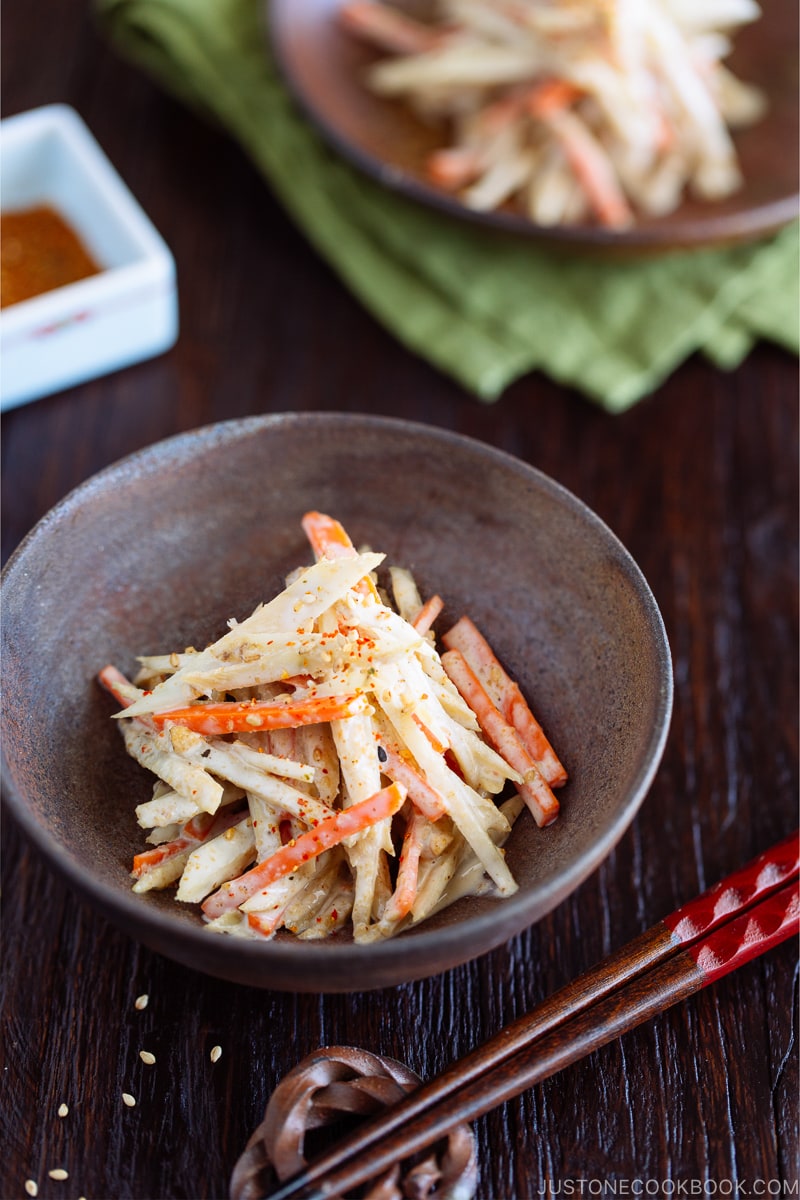
Gobo Salad (ごぼうサラダ) is Japanese burdock salad that’s made with julienned burdock root and carrot blanched until crisp-tender and coated with Japanese mayonnaise-based dressing. It’s crunchy, creamy, and crisp. You’ll find all kinds of sensations in one delicious bite!
If you are adventurous with vegetables, this is a good time to hunt for burdock root at your nearest Asian grocery store in the produce aisle and make this Japanese Gobo Salad. It’s a fantastic everyday salad that pairs brilliantly with just about anything.
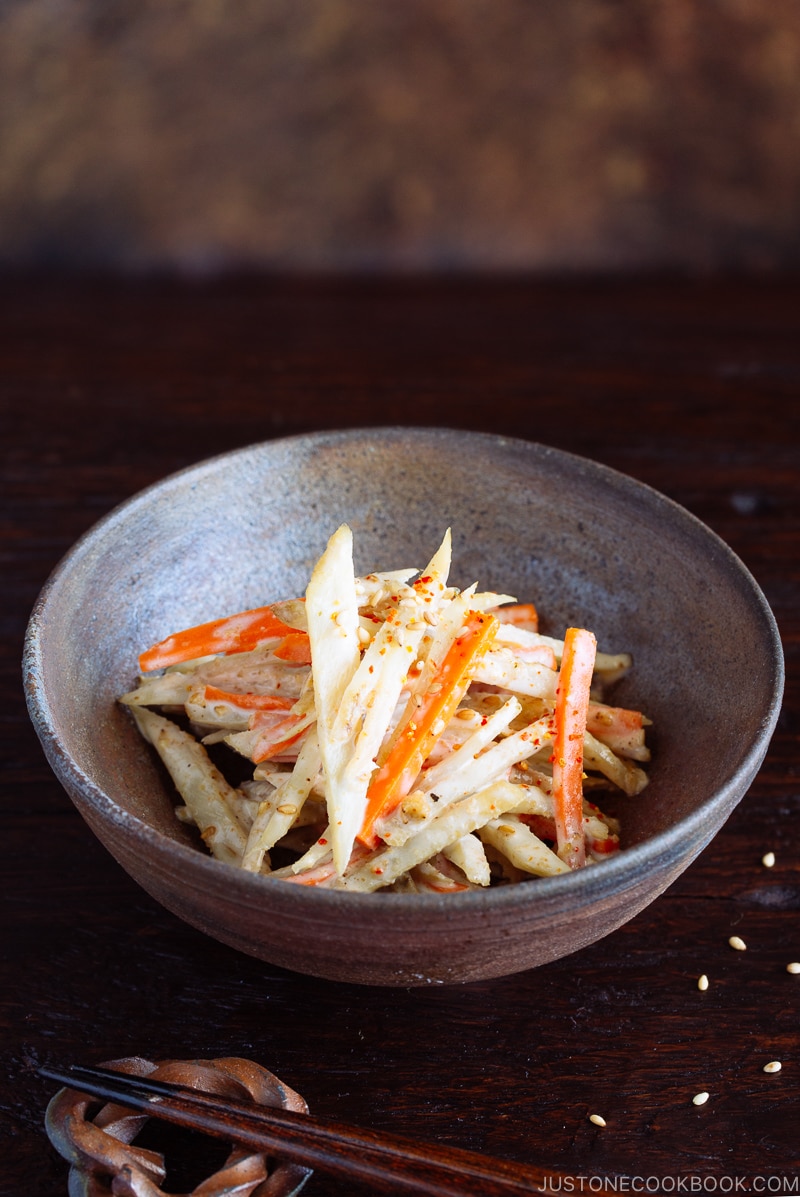
What is Gobo (Burdock Root)?
Gobo is the Japanese name for burdock root, and it is a very popular root vegetable in Japan. It is also known as niúbàng 牛蒡 in Chinese and ueong (우엉) in Korean. If you spotted burdock roots in your Asian markets before, you’ve probably wondered what the heck are these bizarre-looking things for.
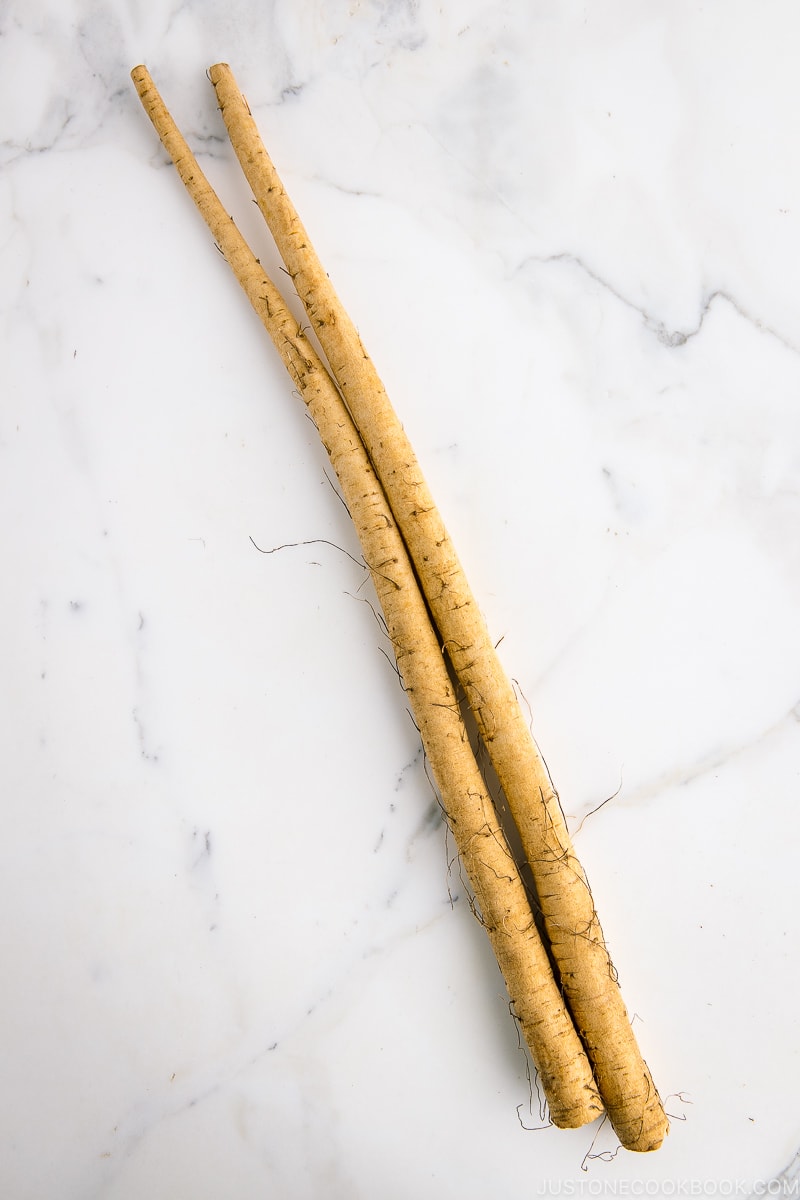
As you can see from the picture above, the gobo looks like a long slender tree root. The texture is hard before cooking, but it gets tender after cooking for a long time. It has a mild, sweet, and distinct earthy taste. Some may describe the flavor of gobo resembles parsnips or artichokes.
Popular Japanese Gobo Recipes
Gobo is one of the common root vegetables used in everyday Japanese home cooking like lotus root, daikon, and carrot. It is often braised, stir-fried, boiled, deep-fried, and stewed. Here are some of the common gobo recipes that I shared on Just One Cookbook.
- Kinpira Gobo (Braised Burdock Root)
- Kenchinjiru (Vegetable Soup – Vegan)
- Chikuzenni (Nishime) (Stewed Chicken and Vegetables)
- Kakiage Donburi (Vegeteable and Shrimp Tempura Rice Bowl)
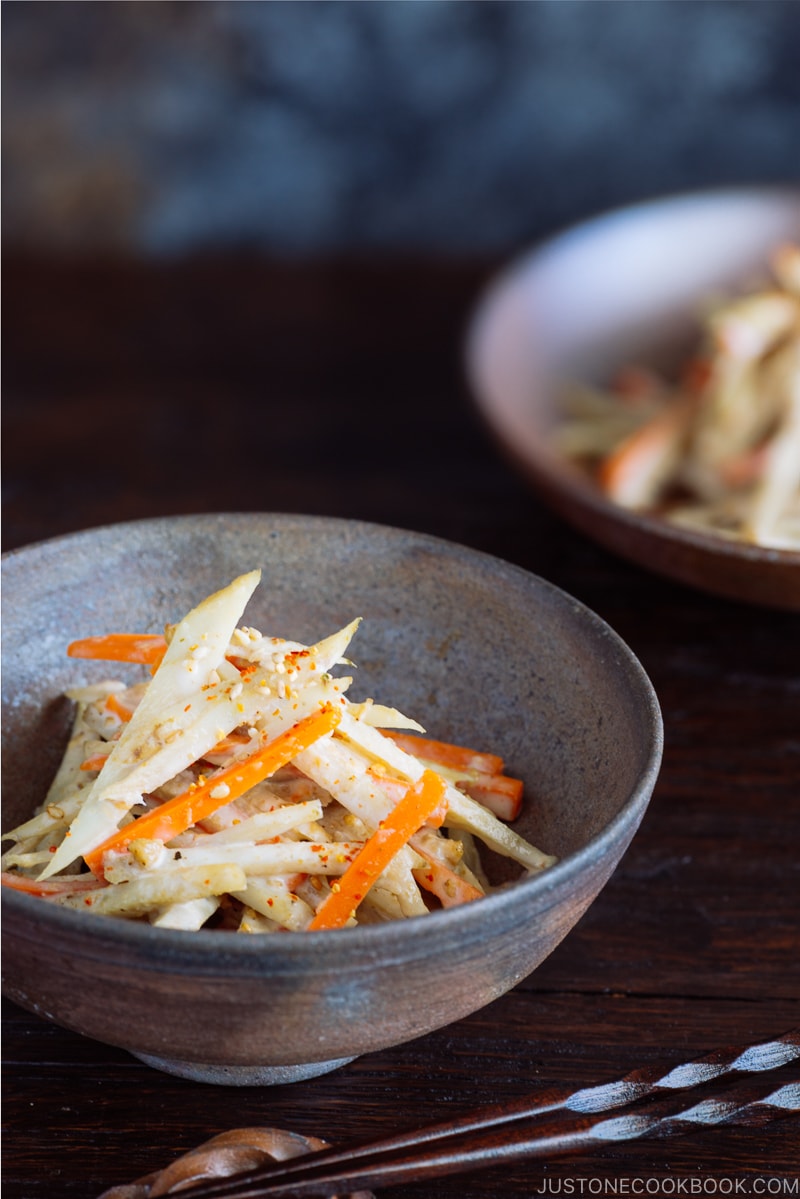
Health Benefits of the Gobo
High in antioxidants and a good source of dietary fiber, gobo or burdock root is eaten for its many health-promoting properties and disease-fighting effects. In East Asia and Europe, gobo has been considered an important herbal ingredient for thousands of years as it contains small quantities of many vital vitamins and some valuable minerals.
Roasted burdock root tea (焙煎ごぼう茶) is a popular way to enjoy its health benefit as the tea is known to detox the body, boost the immune system, soothe stomach disorders, and so on.
Season/Availability of the Gobo
Gobo is available all year round. The new gobo (新ごぼう) is whiter in color and smaller, and it’s in season in early summer around June or July.
How to Preserve the Gobo
If your gobo comes with some dirt, you can wrap it (with dirt) in newspaper and store in a dark cool place for up to 1-2 weeks. Once gobo is washed and clean, it’s best to keep in the refrigerator and use it within a week.
How to Prepare the Gobo
Gobo’s skin is known to have the most nutrients; therefore, it is preferred to scrub off with a brush or scrape off the thin skin by using the back of a knife instead of peeling it off with a peeler.
Traditionally, the common practice is to soak the scraped (peeled) gobo in water to avoid oxidation and to remove the bitterness. However, my mother told me that recent studies show that in order to keep the nutrients, it’s better to wash gobo with a brush and skip the scraping/peeling, and not to soak it in water. However, you will have to use it right away after you cut gobo as it will be quickly oxidized.
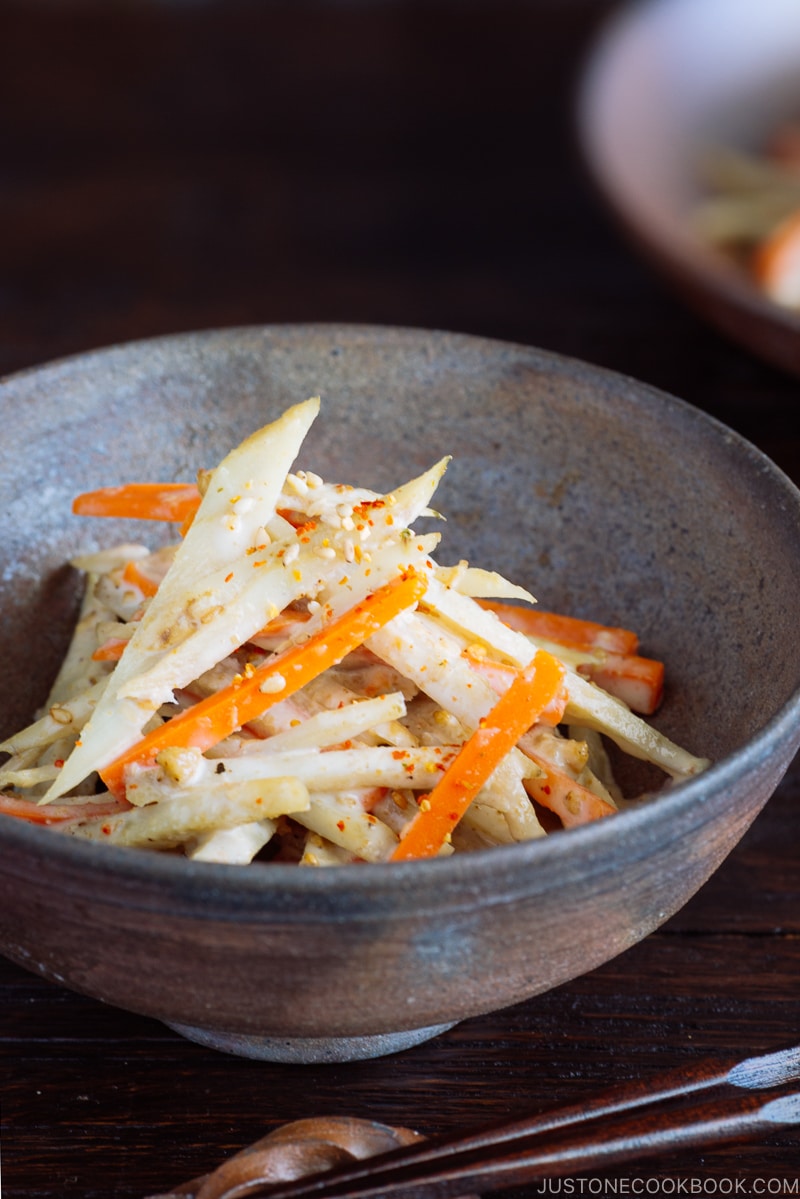
5 Tips to Make Delicious Gobo Salad
1. Scrape the gobo skin and slice diagonally.
The flavors and aroma of gobo are right under the skin, so scrape the thin layer of the skin with the back of a knife instead of using a peeler. Slice diagonally against the grain then cut into julienne pieces.
2. Cook carrot and gobo separately.
In order to retain the textures of gobo and carrots, I recommend cooking them separately as gobo takes a bit longer to cook. Start by cooking the carrot first as gobo has stronger flavor and color. Don’t overcook them as the crunchy root vegetables taste better in a refreshing salad like this.
3. Drain well before seasoning.
Make sure to drain gobo and carrot so that the dressing won’t be diluted by excess water.
4. Season gobo while it is still hot (except for mayonnaise).
Goto takes a longer time to absorb the flavor, so season while it’s hot/warm. However, don’t add the mayonnaise yet. You can add mayo after gobo and carrots are completely cool.
5. Adjust the amount of mayonnaise
Some people like their gobo salads on a creamier side. I personally prefer a lighter dressing, so I cut down on the use of mayonnaise. If you prefer a creamy dressing, you can adjust the amount of mayo after giving it a taste.
For those of you who can’t find Japanese mayonnaise, use the substitute mentioned here.
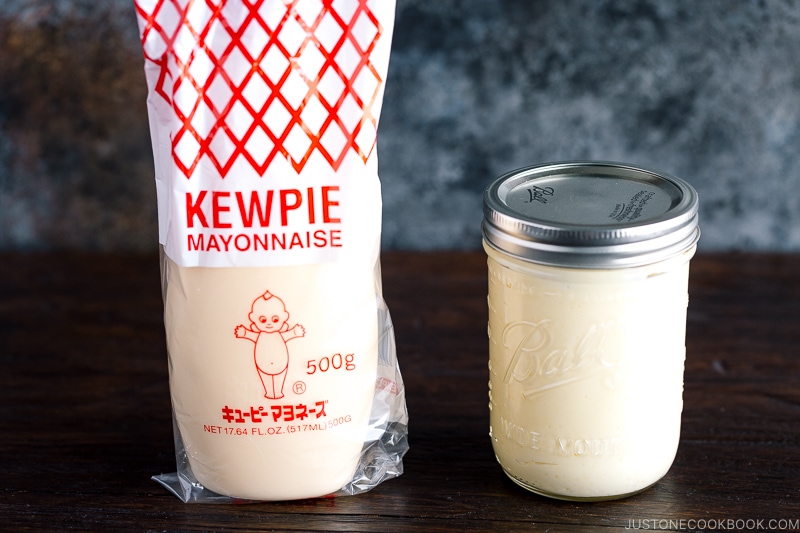
If you like to make Japanese mayonnaise from scratch, you can check my homemade mayonnaise recipe.
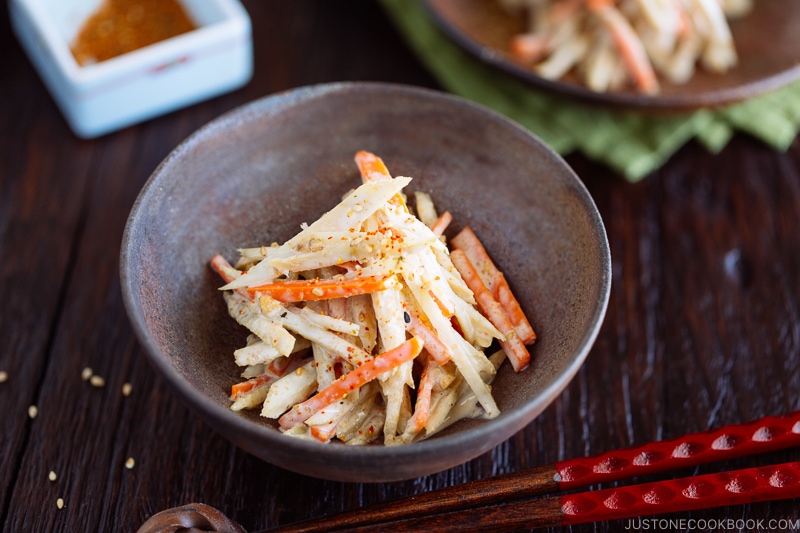
Wish to learn more about Japanese cooking? Sign up for our free newsletter to receive cooking tips & recipe updates! And stay in touch with me on Facebook, Pinterest, YouTube, and Instagram.

Gobo Salad (Japanese Burdock Salad)
Ingredients
- 1 gobo (burdock root) (14 inches, 36 cm; 5.3 oz, 150 g)
- 1½ inches carrot (1 inch, 2.5 cm in diameter; 1.8 oz, 50 g)
- 1 Tbsp rice vinegar (unseasoned)
- ½ tsp soy sauce
- 1 tsp toasted sesame oil
- 1½ tsp sugar
- 3 Tbsp toasted white sesame seeds
- 3 Tbsp Japanese Kewpie mayonnaise (or more, to taste; you can make homemade Kewpie mayonnaise)
- shichimi togarashi (Japanese seven spice)
Instructions
- Gather all the ingredients.
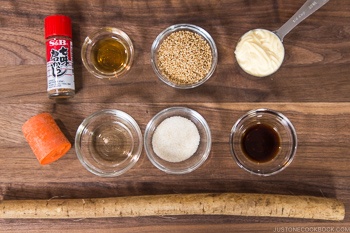
- Wash 1 gobo (burdock root) to get rid of the dirt. Use the back of your knife to scrape off the skin. Cut into thin slices diagonally about ⅛ inch (3 mm) thick.
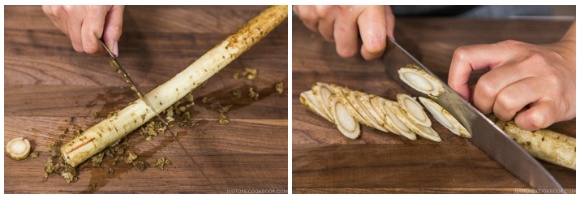
- Then, cut the slices into thin sticks ⅛ inch (3 mm) thick. Soak the gobo in water to minimize oxidation and remove the bitterness.
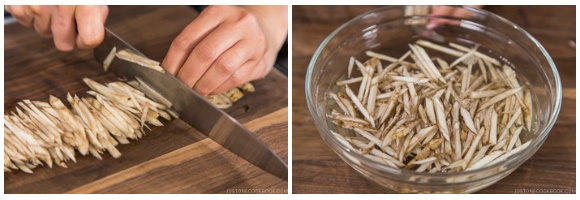
- Peel and cut 1½ inches carrot into thin sticks about the same size as the gobo.
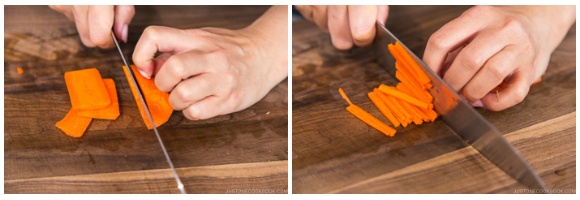
- Bring 2 cups of water to boil and cook the carrot for 1 minute. Scoop up the carrot using a sieve or slotted spoon.
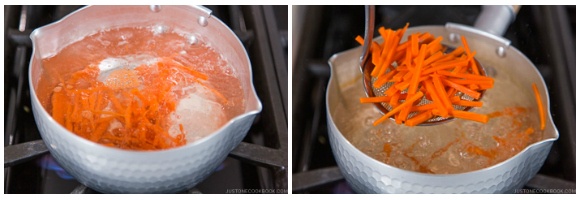
- Then, add the drained gobo into the pot of boiling water and cook for 2 minutes.
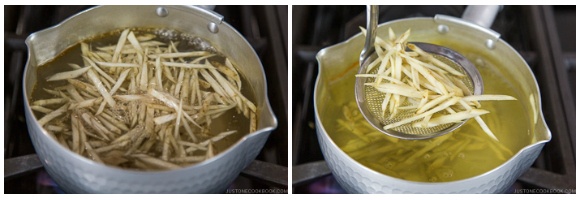
- Drain completely (I use a salad spinner) and transfer to a large bowl.
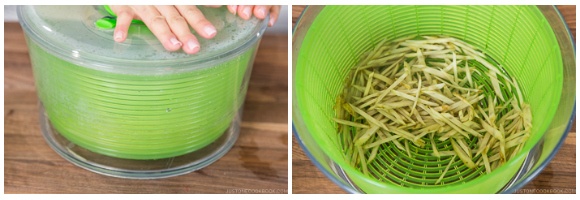
- While the gobo is still hot, add 1 Tbsp rice vinegar (unseasoned), ½ tsp soy sauce, and 1 tsp toasted sesame oil.
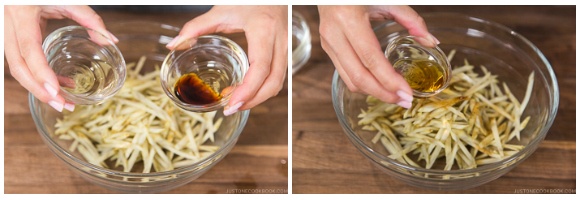
- Add 1½ tsp sugar and mix all together. This helps the gobo absorb the flavors from the seasonings. Let it cool before adding the mayonnaise.
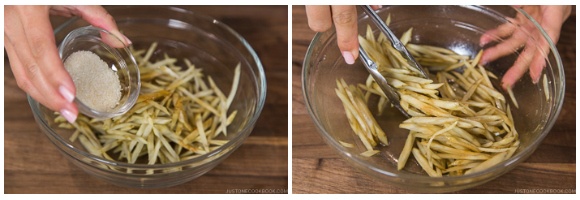
- Grind 3 Tbsp toasted white sesame seeds with a mortar and pestle.
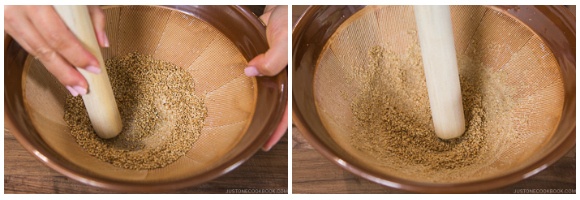
- Add the carrot, 3 Tbsp Japanese Kewpie mayonnaise and the ground sesame seeds. If you like it spicy, sprinkle shichimi togarashi (Japanese seven spice) on top.
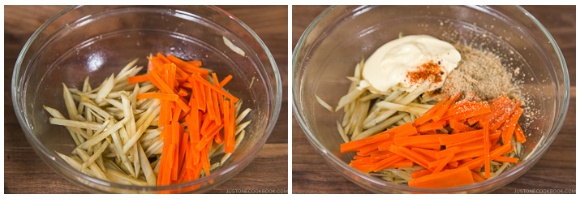
To Store
- Keep the leftovers in an airtight container and store in the refrigerator for up to 3–4 days.
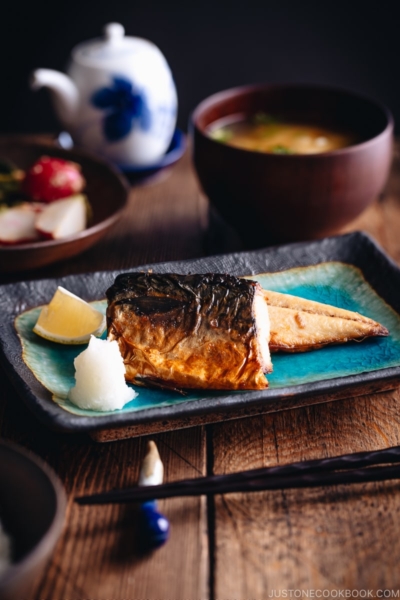
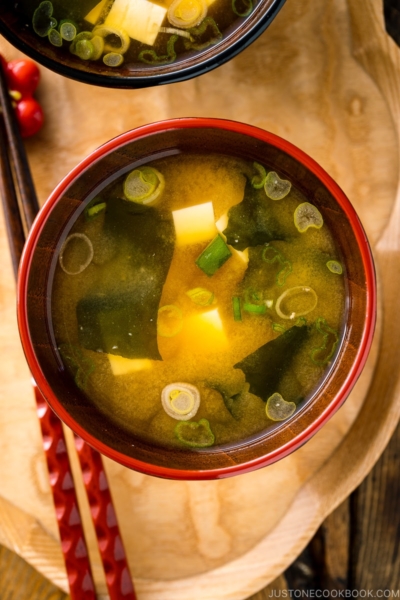
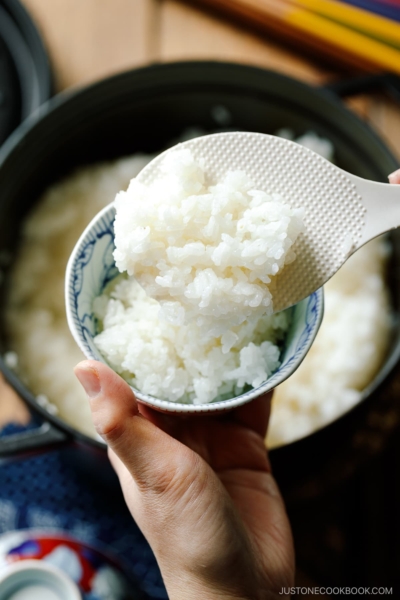
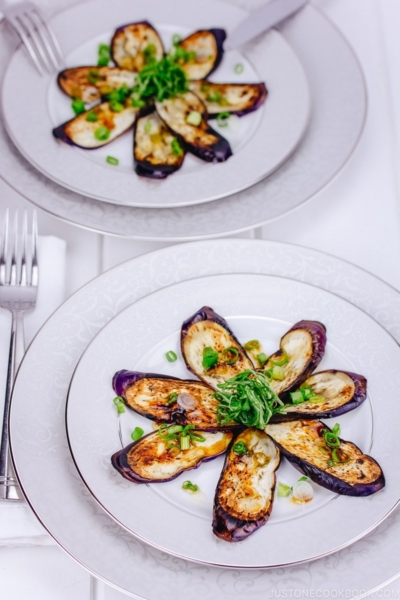




I made this with the teriyaki chicken and hiyayakko last night for dinner. It was a really great meal. I started to make kinpra gobo but liked the idea of a cold salad and this hit the spot.
Hello, Jessica. Thank you for trying Nami’s recipe and for your kind feedback!
Teriyaki chicken, hiyayakko and gobo salad sound wonderful! We’re glad you enjoyed the Japanese meal.☺️ Thank you for sharing your experiences!
I’ve always loved this dish from the first time I tried it. One of my favourite sides for almost any meal of the day.
I appreciate how your methods and order of ingredients help me understand how to enhance the flavour and finish of the dish. I eyeballed the chili (!!) whe. I added and probably made it a bit too spicy for my youngest daughter. Oops! More for me!!
Hello Richard! It’s great to hear that Nami’s instructions and methods have helped you appreciate the flavor of this salad more than ever before!
Thank you for trying Nami’s recipe and for your kind feedback.
We hope that your next attempt will be less spicy for your daughter so that she can enjoy it as well.😁 Happy cooking!
How much of th ego root do. you use? I bought some and the middle seemed kind of fibrous, so I skipped it in case it is tougher.
Sorry for typo. My computer doesn’t know GOBO. :). How much of the GOBO root do you use?
Hello, Almee. Thank you for trying Nami’s recipe!
Nami used a 14″ (36 cm) long Gobo that weighed 5.3 oz (150 g), as mentioned on the recipe card.
We hope this was helpful!
Interesting recipe. Need to try.
Hi Julia! Yes, please give it a try! We hope you enjoy the flavor and texture of this dish!
It would be nice if you included the preparation instructions for gobo on the Pantry/Produce page for it 🙂
Hi Trish! What type of preparation? I included in Step 2, but maybe I missed out on something you wanted to know? Let me know! I’d love to include more tips etc.
Hello Nami, was wondering if any Gobo Salad leftover can be refrigerated for at least a few days? If so, would it taste weird if it was made in advanced, refrigerated, and served cold the next day?
Thank you!
Hi Sharon! No, that’s okay! To store, keep in an airtight container in the refrigerator for up to 3-4 days. 🙂 Enjoy!
Hi Nami,
As always, this was a fabulous dish to prepare. Never knew gobo tasted this good. One thing though, your recipe asks for 3 tablespoons of sesame seeds grounded, however I found two teaspoons to be more than enough to cover the salad. Did I miss something?
Hi Waldo! Thank you so much for trying this recipe. I double checked sesame seed amount in my notebook and it does say 3 Tbsp. I ground them and I am sure I took ground sesame seeds out completely from my suribachi… but I guess you can use less. 🙂 Mine would be more sesame taste. 😀
First thank you JOC team and Nami for helping me bring Japanese cooking into my family’s life. It has been a wonderful journey; tasty, too! I would like to say that initially, when trying Japanese recipes from this site and others, I have assumed that there was too much of one thing or another. I thought so with the sesame in this recipe. But I followed the recipe and it turned out great. The freshly roasted and ground sesame blends so well with the kewpie and the touch of remaining gobo seasoning making a delicious dressing. And, like most slaws, I anticipate an equally delicious thought slightly different experience tomorrow. Thank you so much for all the recipes and information.
Hi Reverend! Aww. Thank you so much for sharing your experience and for your thoughtful feedback.
We are very happy to hear you liked the balance of this dish as much as we do.☺️
Burdock is totally unavailable in any asian market in my state. Can I substitute parsnip for burdock?
Hi Caden! Hmmm sure you can, but to me, parsnip goes well more with citrusy dressing than creamy one tho. Burdock is earthy, so creamy dressing makes it more mild taste.
I absolutely love gobo, I usually have it in Takikomi gohan or your stir fried carrot and gobo. Delicious!
I can tell already that it will be great, but I’m definitely looking forward to trying it. I’m not too sure yet what it would best be served with though.
Hi Emy! I am so happy to hear you like gobo as well, I serve gobo salad with anything… I treat it as one of salad. Since it’s creamy, avoid to serve with creamy dish, like White Stew or gratin. 🙂